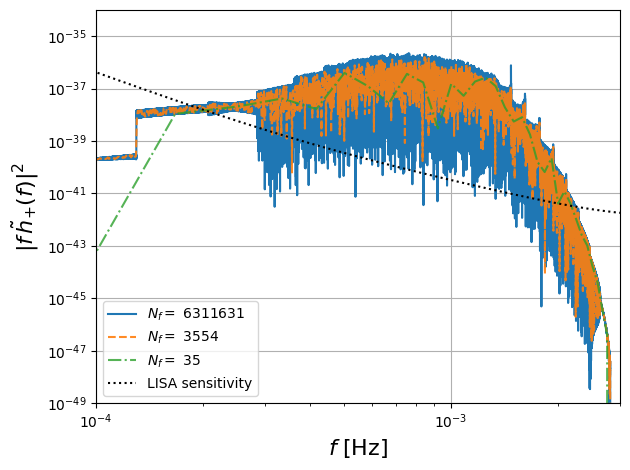EMRI Waveforms in Time and Frequency Domain
In this tutorial, we demonstrate how to use the Fast EMRI Waveform package to produce waveforms in the time domain (TD) as described in arXiv 2104.04582 and in the frequency domain (FD) as described in arXiv 2307.12585. We explore the representation of EMRI waveforms in both domains using a reference source. We compare the TD and FD waveforms using mismatch and estimate the waveform generation speed. Additionally, we explore the impact of spin and eccentricity on the waveform signal-to-noise ratio. Finally, we demonstrate mass invariance and downsampling using the Frequency Domain.
Created by Lorenzo Speri
[2]:
import time
import numpy as np
import matplotlib.pyplot as plt
from few.waveform import GenerateEMRIWaveform
from few.utils.constants import MTSUN_SI
from few.utils.utility import get_p_at_t
from few.utils.geodesic import get_fundamental_frequencies
from few.utils.fdutils import GetFDWaveformFromFD, GetFDWaveformFromTD
from few.trajectory.inspiral import EMRIInspiral
from few.trajectory.ode.flux import KerrEccEqFlux
from scipy.interpolate import CubicSpline
from few import get_file_manager
# produce sensitivity function
traj_module = EMRIInspiral(func=KerrEccEqFlux)
# import ASD
data = np.loadtxt(get_file_manager().get_file("LPA.txt"), skiprows=1)
data[:, 1] = data[:, 1] ** 2
# define PSD function
get_sensitivity = CubicSpline(*data.T)
# define inner product [eq 3 of https://www.nature.com/articles/s41550-022-01849-y]
def inner_product(x, y, psd):
return 4 * np.real(np.sum(np.conj(x) * y / psd))
[3]:
# Initialize waveform generators
# frequency domain generator
few_gen = GenerateEMRIWaveform(
"FastKerrEccentricEquatorialFlux",
sum_kwargs=dict(pad_output=True, output_type="fd", odd_len=True),
return_list=True,
)
# time domain generator
td_gen = GenerateEMRIWaveform(
"FastKerrEccentricEquatorialFlux",
sum_kwargs=dict(pad_output=True, odd_len=True),
return_list=True,
)
# Trick to share waveform generator between both few_gen and td_gen (and reduce
# memory consumption)
td_gen.waveform_generator.amplitude_generator = few_gen.waveform_generator.amplitude_generator
import gc
gc.collect()
[3]:
0
[4]:
# define the injection parameters
m1 = 0.5e6 # central object mass (solar masses)
a = 0.9 # dimensionless spin parameter for the primary - will be ignored in Schwarzschild waveform
m2 = 10.0 # secondary object mass (solar masses)
p0 = 12.0 # initial dimensionless semi-latus rectum
e0 = 0.1 # eccentricity
x0 = 1.0 # initial cos(inclination) - will be ignored in Schwarzschild waveform
qK = np.pi / 3 # polar spin angle
phiK = np.pi / 3 # azimuthal viewing angle
qS = np.pi / 3 # polar sky angle
phiS = np.pi / 3 # azimuthal viewing angle
dist = 1.0 # luminosity distance (Gpc)
# initial phases
Phi_phi0 = np.pi / 3
Phi_theta0 = 0.0
Phi_r0 = np.pi / 3
Tobs = 0.5 # observation time (years), if the inspiral is shorter, the it will be zero padded
dt = 5.0 # time interval (seconds)
mode_selection_threshold = 1e-4 # relative threshold for mode inclusion: only modes making a relative contribution to
# the total power above this threshold will be included in the waveform.
waveform_kwargs = {
"T": Tobs,
"dt": dt,
"mode_selection_threshold": mode_selection_threshold,
}
# get the initial p0 required for an inspiral of length Tobs, given the fixed values of the other parameters
p0 = get_p_at_t(
traj_module,
Tobs * 0.999,
[m1, m2, a, e0, 1.0], # list of trajectory arguments, with p removed
index_of_p=3, # index where to insert the new p values in the above traj_args list when traj_module is called
index_of_a=2, # index of a in the list of trajectory arguments when calling traj_module
index_of_e=4, # etc...
index_of_x=5,
traj_kwargs={},
xtol=2e-12, # absolute tolerance for the brentq root finder
rtol=8.881784197001252e-16, # relative tolerance for the brentq root finder
bounds=None,
)
print("New p0: ", p0)
emri_injection_params = [
m1,
m2,
a,
p0,
e0,
x0,
dist,
qS,
phiS,
qK,
phiK,
Phi_phi0,
Phi_theta0,
Phi_r0,
]
New p0: 8.550184244535393
Comparing Time and Frequency domain waveforms
[5]:
# generate the TD signal, and time how long it takes
start = time.time()
data_channels_td = td_gen(*emri_injection_params, **waveform_kwargs) # Returns 2 arrays containing the plus and cross polarizations
end = time.time()
print("Time taken to generate the TD signal: ", end - start, "seconds")
# take the FFT of the plus polarization and shift it
fft_TD = np.fft.fftshift(np.fft.fft(data_channels_td[0])) * dt
freq = np.fft.fftshift(np.fft.fftfreq(len(data_channels_td[0]), dt))
# define the positive frequencies
positive_frequency_mask = freq >= 0.0
Time taken to generate the TD signal: 6.446015357971191 seconds
[6]:
plt.figure()
plt.loglog(freq[positive_frequency_mask], np.abs(fft_TD[positive_frequency_mask]) ** 2)
plt.loglog(
freq[positive_frequency_mask], get_sensitivity(freq[positive_frequency_mask])
)
plt.ylabel(r"$| {\rm DFT} [h_{+}]|^2$")
plt.xlabel(r"$f$ [Hz]")
plt.xlim(1e-4, 1e-1)
plt.show()

[7]:
# you can specify the frequencies or obtain them directly from the waveform
fd_kwargs = waveform_kwargs.copy()
fd_kwargs["f_arr"] = freq # frequencies at which to output the waveform (optional)
fd_kwargs["mask_positive"] = True # only output FD waveform at positive frequencies
# generate the FD signal directly, and time how long it takes
start = time.time()
hf = few_gen(*emri_injection_params, **fd_kwargs)
end = time.time()
print("Time taken to generate the FD signal: ", end - start, "seconds")
# to get the frequencies:
freq_fd = few_gen.waveform_generator.create_waveform.frequency
# calculate the mismatch between the FFT'd TD waveform and the direct FD waveform:
psd = get_sensitivity(freq[positive_frequency_mask]) / np.diff(freq)[0]
td_td = inner_product(
fft_TD[positive_frequency_mask], fft_TD[positive_frequency_mask], psd
)
fd_fd = inner_product(hf[0], hf[0], psd)
Mism = np.abs(
1
- inner_product(fft_TD[positive_frequency_mask], hf[0], psd)
/ np.sqrt(td_td * fd_fd)
)
print("mismatch", Mism)
# SNR
print("TD SNR", np.sqrt(td_td))
print("FD SNR", np.sqrt(fd_fd))
Time taken to generate the FD signal: 1.889267921447754 seconds
mismatch 0.0003769766918217954
TD SNR 59.741832155263346
FD SNR 59.74122812570039
[8]:
# FD plot
plt.figure()
plt.loglog(
freq[positive_frequency_mask],
np.abs(fft_TD[positive_frequency_mask]) ** 2,
label="DFT of TD waveform",
)
plt.loglog(freq[positive_frequency_mask], np.abs(hf[0]) ** 2, "--", label="FD waveform")
plt.loglog(
freq[positive_frequency_mask],
get_sensitivity(freq[positive_frequency_mask]),
"k:",
label="LISA sensitivity",
)
plt.ylabel(r"$| \tilde{h}_{+} (f)|^2$", fontsize=16)
plt.grid()
plt.xlabel(r"$f$ [Hz]", fontsize=16)
plt.legend()
plt.ylim([0.5e-41, 1e-32])
plt.xlim([1e-4, 1e-1])
plt.show()
# plt.savefig('figures/FD_TD_frequency.pdf', bbox_inches='tight')
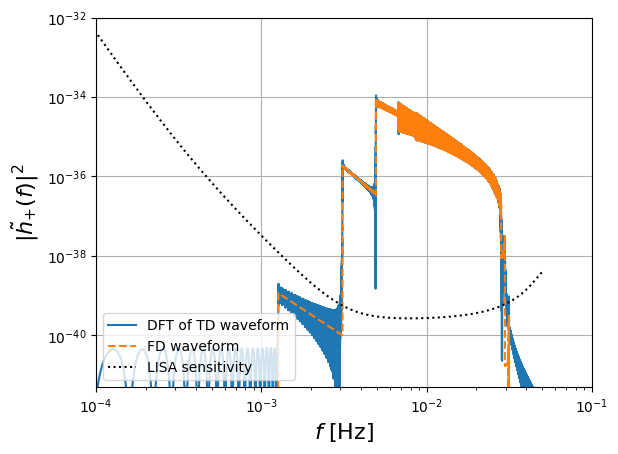
In the following example we transform the FD waveform to the time domain, and compare to the directly generated TD waveform:
[9]:
# regenerate the FD waveform, outputting the negative frequencies too this time
fd_kwargs_temp = waveform_kwargs.copy()
fd_kwargs_temp["f_arr"] = freq
fd_kwargs_temp["mask_positive"] = False # do not mask the positive frequencies
hf_temp = few_gen(*emri_injection_params, **fd_kwargs_temp)
# check the consistency with the previous masked waveform
assert np.sum(hf_temp[0][positive_frequency_mask] - hf[0]) == 0.0
# transform FD waveform to TD
hf_to_ifft = np.append(
hf_temp[0][positive_frequency_mask], hf_temp[0][~positive_frequency_mask]
)
[10]:
# Plot the waveforms in the time domain
plt.figure()
time_array = np.arange(0, len(data_channels_td[0])) * dt
plt.plot(time_array, data_channels_td[0].real, label="TD waveform")
ifft_fd = np.fft.ifft(hf_to_ifft / dt)
plt.plot(time_array, ifft_fd.real, "--", label="Inverse DFT (FD waveform)")
plt.ylabel(r"$h_{+}(t)$")
plt.xlabel(r"$t$ [s]")
t0 = time_array[-1] * 0.7
space_t = 10e3
plt.xlim([t0, t0 + space_t / 2])
plt.ylim([-4e-22, 6e-22])
plt.legend(loc="upper center")
plt.show()
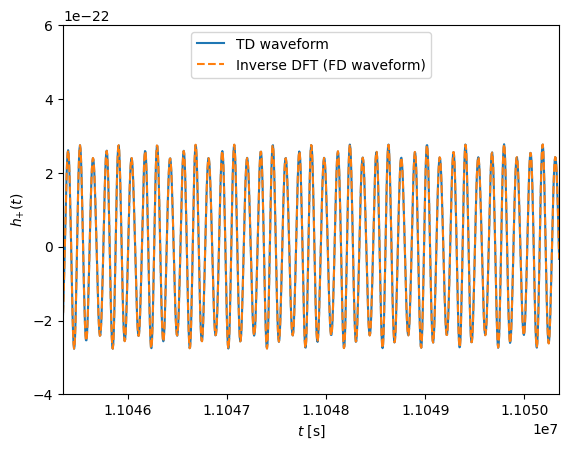
In the following example we generate a downsampled FD waveform using the “f_arr” argument:
[11]:
# construct downsampled frequency array
df = np.diff(freq)[0]
fmin, fmax = df, freq.max()
fmin, fmax = 1e-3, 5e-2
num_pts = 500
p_freq = np.append(0.0, np.linspace(fmin, fmax, num_pts))
freq_temp = np.hstack((-p_freq[::-1][:-1], p_freq))
# populate kwarg dictionary
fd_kwargs_ds = waveform_kwargs.copy()
fd_kwargs_ds["f_arr"] = freq_temp
fd_kwargs_ds["mask_positive"] = False
# get FD waveform with downsampled frequencies
hf_ds = few_gen(*emri_injection_params, **fd_kwargs_ds)
hf = few_gen(*emri_injection_params, **fd_kwargs)
# time the generation of the FD signal
start = time.time()
hf_ds = few_gen(*emri_injection_params, **fd_kwargs_ds)
end = time.time()
print("Time taken to generate the FD signal: ", end - start, "seconds")
# to get the frequencies:
freq_fd = few_gen.waveform_generator.create_waveform.frequency
# freq_temp = freq_temp[freq_temp>=0.0]
print("freq_fd", freq_fd.shape, "h shape", hf[0].shape)
# FD plot
plt.figure()
plt.loglog(freq[positive_frequency_mask], np.abs(hf[0])**2, "-", label="FD waveform")
plt.loglog(freq_fd, np.abs(hf_ds[0])**2, "--", label="FD waveform Downsample")
plt.plot(freq_temp, get_sensitivity(freq_temp), "k:", label="LISA sensitivity")
plt.ylabel(r"$| \tilde{h}_{+} (f)|^2$", fontsize=16)
plt.grid()
plt.xlabel(r"$f$ [Hz]", fontsize=16)
plt.legend(loc="upper left")
plt.ylim([0.5e-41, 1e-32])
plt.xlim([1e-4, 5e-2])
plt.show()
# plt.savefig('figures/FD_TD_frequency.pdf', bbox_inches='tight')
Time taken to generate the FD signal: 0.2683577537536621 seconds
freq_fd (1001,) h shape (1577908,)
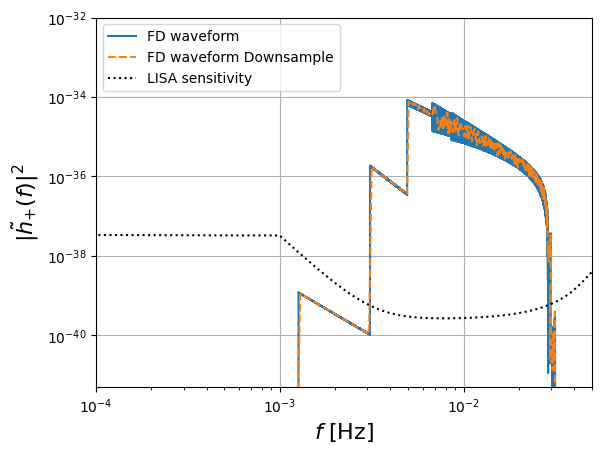
FD utilities and windowing
The generation of FD waveforms using a given choice of waveform generator (either TD or FD) can be simplified using the GetFDWaveformFromTD and GetFDWaveformFromFD classes from the utilities module. These classes allow one to easily specify a choice of window function to use, as illustrated by the following example:
[12]:
from scipy.signal.windows import tukey
fd_kwargs_nomask = fd_kwargs.copy()
del fd_kwargs_nomask["mask_positive"]
# no windowing
window = np.ones(len(data_channels_td[0]))
fft_td_gen = GetFDWaveformFromTD(td_gen, positive_frequency_mask, dt, window=window) # generate an FD waveform by FFT'ing a TD waveform
fd_gen = GetFDWaveformFromFD(few_gen, positive_frequency_mask, dt, window=window) # generate an FD waveform directly using an FD generator
np.all(fd_gen(*emri_injection_params, **fd_kwargs_nomask)[0] == hf[0])
hf = fd_gen(*emri_injection_params, **fd_kwargs_nomask)
fft_TD = fft_td_gen(*emri_injection_params, **fd_kwargs_nomask)
# calculate SNRs and mismatch
psd = get_sensitivity(freq[positive_frequency_mask]) / np.diff(freq)[0]
td_td = inner_product(fft_TD[0], fft_TD[0], psd)
fd_fd = inner_product(hf[0], hf[0], psd)
Mism = np.abs(1 - inner_product(fft_TD[0], hf[0], psd) / np.sqrt(td_td * fd_fd))
print(" ***** No window ***** ")
print("mismatch", Mism)
print("TD SNR", np.sqrt(td_td))
print("FD SNR", np.sqrt(fd_fd))
# add windowing
window = np.asarray(tukey(len(data_channels_td[0]), 0.01))
fft_td_gen = GetFDWaveformFromTD(td_gen, positive_frequency_mask, dt, window=window)
fd_gen = GetFDWaveformFromFD(few_gen, positive_frequency_mask, dt, window=window)
hf_win = fd_gen(*emri_injection_params, **fd_kwargs_nomask)
fft_TD_win = fft_td_gen(*emri_injection_params, **fd_kwargs_nomask)
# calculate SNRs and mismatch
psd = get_sensitivity(freq[positive_frequency_mask]) / np.diff(freq)[0]
td_td = inner_product(fft_TD_win[0], fft_TD_win[0], psd)
fd_fd = inner_product(hf_win[0], hf_win[0], psd)
Mism = np.abs(1 - inner_product(fft_TD_win[0], hf_win[0], psd) / np.sqrt(td_td * fd_fd))
print("\n\n ***** With window ***** ")
print("mismatch", Mism)
print("TD SNR", np.sqrt(td_td))
print("FD SNR", np.sqrt(fd_fd))
***** No window *****
mismatch 0.00037697669182157334
TD SNR 59.741832155263346
FD SNR 59.74122812570041
***** With window *****
mismatch 0.00014232836326399934
TD SNR 59.536970704688024
FD SNR 59.55122751717226
[13]:
# FD plot
plt.figure(figsize=(6, 9))
plt.subplot(2,1,1)
plt.title("Unwindowed", fontsize=16)
plt.loglog(
freq[positive_frequency_mask], np.abs(fft_TD[0]) ** 2, label="DFT of TD waveform"
)
plt.loglog(freq[positive_frequency_mask], np.abs(hf[0]) ** 2, "--", label="FD waveform")
plt.loglog(
freq[positive_frequency_mask],
get_sensitivity(freq[positive_frequency_mask]),
"k:",
label="LISA sensitivity",
)
plt.ylabel(r"$| \tilde{h}_{+}(f)|^2$", fontsize=16)
plt.xlabel(r"$f$ [Hz]", fontsize=16)
plt.legend(loc='upper left')
plt.grid()
plt.ylim([0.5e-41, 1e-32])
plt.xlim([1e-4, 1e-1])
#plt.show()
# plt.savefig('figures/FD_TD_frequency_windowed.pdf', bbox_inches='tight')
plt.subplot(2,1,2)
plt.title("Windowed", fontsize=16)
plt.loglog(
freq[positive_frequency_mask], np.abs(fft_TD_win[0]) ** 2, label="DFT of TD waveform"
)
plt.loglog(freq[positive_frequency_mask], np.abs(hf_win[0]) ** 2, "--", label="FD waveform")
plt.loglog(
freq[positive_frequency_mask],
get_sensitivity(freq[positive_frequency_mask]),
"k:",
label="LISA sensitivity",
)
plt.ylabel(r"$| \tilde{h}_{+}(f)|^2$", fontsize=16)
plt.xlabel(r"$f$ [Hz]", fontsize=16)
plt.legend(loc='upper left')
plt.grid()
plt.ylim([0.5e-41, 1e-32])
plt.xlim([1e-4, 1e-1])
plt.gcf().tight_layout()

Signal to noise ratio as a function of eccentricity and spin
[15]:
def calculate_snr_mismatch(
mode,
emri_injection_params,
waveform_kwargs,
fd_kwargs,
freq,
positive_frequency_mask,
dt,
):
# Update fd_kwargs and td_kwargs with the current mode
fd_kwargs = fd_kwargs.copy()
fd_kwargs.pop("mode_selection_threshold")
fd_kwargs["mode_selection"] = [mode]
hf_mode = few_gen(*emri_injection_params, **fd_kwargs)
td_kwargs2 = waveform_kwargs.copy()
td_kwargs2.pop("mode_selection_threshold")
td_kwargs2["mode_selection"] = [mode]
data_channels_td_mode = td_gen(*emri_injection_params, **td_kwargs2)
# Take the FFT of the plus polarization and shift it
fft_TD_mode = np.fft.fftshift(np.fft.fft(data_channels_td_mode[0])) * dt
# Calculate PSD
psd = get_sensitivity(freq[positive_frequency_mask]) / np.diff(freq)[0]
# Calculate inner products
td_td = inner_product(
fft_TD_mode[positive_frequency_mask], fft_TD_mode[positive_frequency_mask], psd
)
fd_fd = inner_product(hf_mode[0], hf_mode[0], psd)
Mism = np.abs(
1
- inner_product(fft_TD_mode[positive_frequency_mask], hf_mode[0], psd)
/ np.sqrt(td_td * fd_fd)
)
# calculated frequency
OmegaPhi, OmegaTheta, OmegaR = get_fundamental_frequencies(
emri_injection_params[2],
emri_injection_params[3],
emri_injection_params[4],
emri_injection_params[5],
)
harmonic_frequency = (OmegaPhi * mode[1] + OmegaR * mode[2]) / (
emri_injection_params[0] * MTSUN_SI * 2 * np.pi
)
return np.sqrt(td_td), Mism, harmonic_frequency
# Initialize data storage
data_out = []
# mode vector
eccentricity_vector = [0.1, 0.3, 0.7]
max_n_vector = [10, 18, 26]
spin_vector = [0.0, 0.9]
for a in spin_vector:
for l_set, m_set in zip([2], [2]):
temp = emri_injection_params.copy()
for e_temp, max_n in zip(eccentricity_vector, max_n_vector):
modes = [(l_set, m_set, ii) for ii in range(-3, max_n)]
p_temp = get_p_at_t(
traj_module,
Tobs * 0.99,
[m1, m2, a, e_temp, 1.0],
index_of_p=3,
index_of_a=2,
index_of_e=4,
index_of_x=5,
traj_kwargs={},
xtol=2e-12,
rtol=8.881784197001252e-16,
bounds=None,
)
temp[3] = p_temp
temp[4] = e_temp
temp[2] = a
out = np.asarray(
[
calculate_snr_mismatch(
mode,
temp,
waveform_kwargs,
fd_kwargs,
freq,
positive_frequency_mask,
dt,
)
for mode in modes
]
)
snr, Mism, harmonic_frequency = out.T
data_out.append((harmonic_frequency, snr, l_set, m_set, e_temp, a))
[16]:
# Plot the data
colors = {0.1: "royalblue", 0.3: "seagreen", 0.5: "crimson", 0.7: "darkviolet"}
plt.figure(figsize=(8, 5))
for harmonic_frequency, snr, l_set, m_set, e_temp, a in data_out:
color = colors[e_temp]
if a == 0.9:
plt.plot(
harmonic_frequency,
20.0 * snr / np.sum(snr**2) ** 0.5,
":P",
label=f"e = {e_temp}, a = {a}",
color=color,
)
# plt.text(harmonic_frequency[-1], 20.0 * snr[-1]/np.sum(snr**2)**0.5, f"({l_set},{m_set})", fontsize=8)
if a == 0.0:
plt.plot(
harmonic_frequency,
20.0 * snr / np.sum(snr**2) ** 0.5,
"--o",
label=f"e = {e_temp}, a = {a}",
color=color,
)
# for ii in range(len(harmonic_frequency)):
# plt.text(harmonic_frequency[ii], 20.0 * snr[ii]/np.sum(snr**2)**0.5, f"n={ii-3}", fontsize=8)
plt.xlabel("Initial Harmonic Frequency [Hz]")
plt.ylabel("20 x SNR / Total SNR")
plt.title(
f"SNR per each harmonic (m,n) = ({2},n) for m1={m1:.2e}, m2={m2:.2e} and plunge in {Tobs} years"
)
plt.xlim(0, 0.012)
plt.grid()
plt.legend()
plt.show()
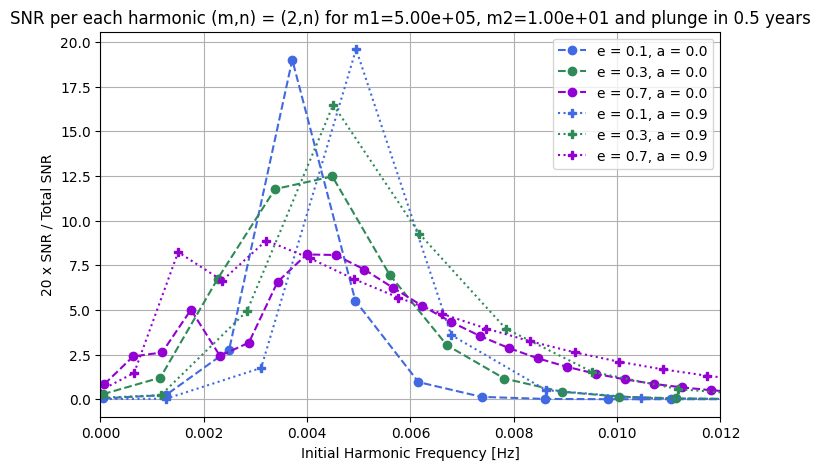
[17]:
# Initialize data storage
data_out = []
# mode vector
a = 0.0
Tobs = 0.1 # observation time, if the inspiral is shorter, the it will be zero padded
eccentricity_vector = [0.1, 0.5]
max_n_vector = [10, 26]
eta_vector = [1e-4, 1e-6] # mass ratio values
for eta in eta_vector:
for e_temp, max_n in zip(eccentricity_vector, max_n_vector):
temp = emri_injection_params.copy()
m2 = eta * m1
p_temp = get_p_at_t(
traj_module,
Tobs * 0.99,
[m1, m2, a, e_temp, 1.0],
index_of_p=3,
index_of_a=2,
index_of_e=4,
index_of_x=5,
traj_kwargs={},
xtol=2e-6,
rtol=8.881784197001252e-6,
)
temp[3] = p_temp
temp[4] = e_temp
temp[1] = m2
for l_set, m_set in zip([2], [2]):
modes = [(l_set, m_set, ii) for ii in range(-3, max_n)]
out = np.asarray(
[
calculate_snr_mismatch(
mode,
temp,
waveform_kwargs,
fd_kwargs,
freq,
positive_frequency_mask,
dt,
)
for mode in modes
]
)
snr, Mism, harmonic_frequency = out.T
data_out.append((harmonic_frequency, snr, l_set, m_set, e_temp, eta))
[18]:
# Plot the data
colors = {0.1: "royalblue", 0.3: "seagreen", 0.5: "crimson", 0.7: "darkviolet"}
plt.figure(figsize=(8, 5))
for harmonic_frequency, snr, l_set, m_set, e_temp, eta_temp in data_out:
color = colors[e_temp]
if eta_temp == 1e-4:
plt.plot(
harmonic_frequency,
20.0 * snr / np.sum(snr**2) ** 0.5,
"-P",
label=f"e = {e_temp}, m2/m1={eta_temp:.1e}",
color=color,
)
if eta_temp == 1e-6:
plt.plot(
harmonic_frequency,
20.0 * snr / np.sum(snr**2) ** 0.5,
":X",
label=f"e = {e_temp}, m2/m1={eta_temp:.1e}",
color=color,
)
plt.xlabel("Initial Harmonic Frequency [Hz]")
plt.ylabel("20 x SNR / Total SNR")
plt.title(
f"SNR per each harmonic (m,n) = ({2},n) for m1={m1:.2e} and plunge in {Tobs} years"
)
plt.xlim(0, 0.03)
plt.grid()
plt.legend()
plt.show()
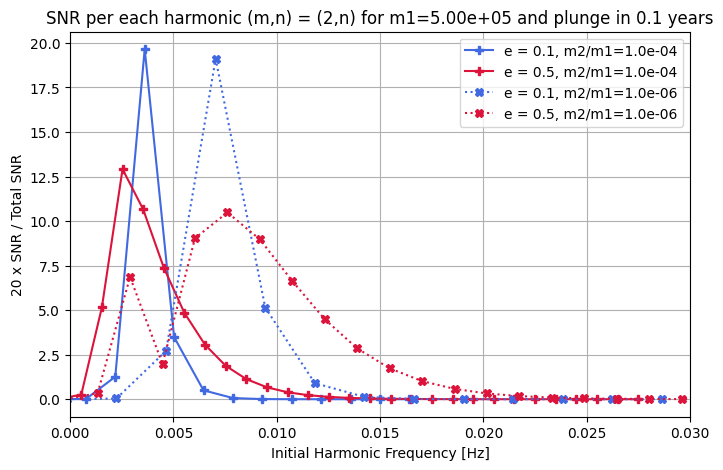
Speed test as a function of the parameter space
[19]:
# create a function that times the FD and TD waveform generation for different input parameters
def time_waveform_generation(fd_waveform_func, td_waveform_func, input_params, kwargs):
"""
Times the FD and TD waveform generation for different input parameters.
Parameters:
fd_waveform_func (function): Function to generate FD waveform.
td_waveform_func (function): Function to generate TD waveform.
input_params (list): List of dictionaries containing input parameters for the waveform functions.
Returns:
list: List of dictionaries containing input parameters and their corresponding FD and TD generation times.
"""
results = []
for params in input_params:
# Time FD waveform generation
start_time = time.time()
fd_waveform_func(*params, **kwargs)
fd_time = time.time() - start_time
# Time TD waveform generation
start_time = time.time()
td_waveform_func(*params, **kwargs)
td_time = time.time() - start_time
# Store the results
result = {"input_params": params, "fd_time": fd_time, "td_time": td_time}
print(result)
results.append(result)
return results
timing_results = []
vec_par = []
Tobs = 2.0
# create a list of input parameters for m1, m2, a, p0, e0, x0
for mass in [1e5, 1e6, 1e7]:
for el in np.linspace(0.1, 0.6, num=3):
temp = emri_injection_params.copy()
temp[0] = mass
temp[4] = el
temp[3] = get_p_at_t(
traj_module,
Tobs * 0.99,
[temp[0], temp[1], temp[2], temp[4], 1.0],
index_of_p=3,
index_of_a=2,
index_of_e=4,
index_of_x=5,
traj_kwargs={},
xtol=2e-6,
rtol=8.881784197001252e-6,
)
vec_par.append(temp.copy())
waveform_kwargs = {
"T": Tobs,
"dt": dt,
"mode_selection_threshold": 1e-2,
}
timing_results = time_waveform_generation(few_gen, td_gen, vec_par, waveform_kwargs)
print(timing_results)
{'input_params': [100000.0, 10.0, 0.9, 27.80352723778368, 0.1, 1.0, 1.0, 1.0471975511965976, 1.0471975511965976, 1.0471975511965976, 1.0471975511965976, 1.0471975511965976, 0.0, 1.0471975511965976], 'fd_time': 6.0413548946380615, 'td_time': 1.2838618755340576}
{'input_params': [100000.0, 10.0, 0.9, 27.51402838748775, 0.35, 1.0, 1.0, 1.0471975511965976, 1.0471975511965976, 1.0471975511965976, 1.0471975511965976, 1.0471975511965976, 0.0, 1.0471975511965976], 'fd_time': 10.19678807258606, 'td_time': 1.8822479248046875}
{'input_params': [100000.0, 10.0, 0.9, 26.566565101687495, 0.6, 1.0, 1.0, 1.0471975511965976, 1.0471975511965976, 1.0471975511965976, 1.0471975511965976, 1.0471975511965976, 0.0, 1.0471975511965976], 'fd_time': 20.180485010147095, 'td_time': 3.652083158493042}
{'input_params': [1000000.0, 10.0, 0.9, 8.530368946845986, 0.1, 1.0, 1.0, 1.0471975511965976, 1.0471975511965976, 1.0471975511965976, 1.0471975511965976, 1.0471975511965976, 0.0, 1.0471975511965976], 'fd_time': 2.1328768730163574, 'td_time': 1.7280950546264648}
{'input_params': [1000000.0, 10.0, 0.9, 8.477092794460157, 0.35, 1.0, 1.0, 1.0471975511965976, 1.0471975511965976, 1.0471975511965976, 1.0471975511965976, 1.0471975511965976, 0.0, 1.0471975511965976], 'fd_time': 3.1470630168914795, 'td_time': 2.5998878479003906}
{'input_params': [1000000.0, 10.0, 0.9, 8.270079444955954, 0.6, 1.0, 1.0, 1.0471975511965976, 1.0471975511965976, 1.0471975511965976, 1.0471975511965976, 1.0471975511965976, 0.0, 1.0471975511965976], 'fd_time': 5.76480507850647, 'td_time': 4.290946006774902}
{'input_params': [10000000.0, 10.0, 0.9, 3.1415736316879297, 0.1, 1.0, 1.0, 1.0471975511965976, 1.0471975511965976, 1.0471975511965976, 1.0471975511965976, 1.0471975511965976, 0.0, 1.0471975511965976], 'fd_time': 0.7956430912017822, 'td_time': 2.4750730991363525}
{'input_params': [10000000.0, 10.0, 0.9, 3.247517449366446, 0.35, 1.0, 1.0, 1.0471975511965976, 1.0471975511965976, 1.0471975511965976, 1.0471975511965976, 1.0471975511965976, 0.0, 1.0471975511965976], 'fd_time': 0.8679220676422119, 'td_time': 3.3655760288238525}
{'input_params': [10000000.0, 10.0, 0.9, 3.4020410949990105, 0.6, 1.0, 1.0, 1.0471975511965976, 1.0471975511965976, 1.0471975511965976, 1.0471975511965976, 1.0471975511965976, 0.0, 1.0471975511965976], 'fd_time': 0.9677088260650635, 'td_time': 4.526573181152344}
[{'input_params': [100000.0, 10.0, 0.9, 27.80352723778368, 0.1, 1.0, 1.0, 1.0471975511965976, 1.0471975511965976, 1.0471975511965976, 1.0471975511965976, 1.0471975511965976, 0.0, 1.0471975511965976], 'fd_time': 6.0413548946380615, 'td_time': 1.2838618755340576}, {'input_params': [100000.0, 10.0, 0.9, 27.51402838748775, 0.35, 1.0, 1.0, 1.0471975511965976, 1.0471975511965976, 1.0471975511965976, 1.0471975511965976, 1.0471975511965976, 0.0, 1.0471975511965976], 'fd_time': 10.19678807258606, 'td_time': 1.8822479248046875}, {'input_params': [100000.0, 10.0, 0.9, 26.566565101687495, 0.6, 1.0, 1.0, 1.0471975511965976, 1.0471975511965976, 1.0471975511965976, 1.0471975511965976, 1.0471975511965976, 0.0, 1.0471975511965976], 'fd_time': 20.180485010147095, 'td_time': 3.652083158493042}, {'input_params': [1000000.0, 10.0, 0.9, 8.530368946845986, 0.1, 1.0, 1.0, 1.0471975511965976, 1.0471975511965976, 1.0471975511965976, 1.0471975511965976, 1.0471975511965976, 0.0, 1.0471975511965976], 'fd_time': 2.1328768730163574, 'td_time': 1.7280950546264648}, {'input_params': [1000000.0, 10.0, 0.9, 8.477092794460157, 0.35, 1.0, 1.0, 1.0471975511965976, 1.0471975511965976, 1.0471975511965976, 1.0471975511965976, 1.0471975511965976, 0.0, 1.0471975511965976], 'fd_time': 3.1470630168914795, 'td_time': 2.5998878479003906}, {'input_params': [1000000.0, 10.0, 0.9, 8.270079444955954, 0.6, 1.0, 1.0, 1.0471975511965976, 1.0471975511965976, 1.0471975511965976, 1.0471975511965976, 1.0471975511965976, 0.0, 1.0471975511965976], 'fd_time': 5.76480507850647, 'td_time': 4.290946006774902}, {'input_params': [10000000.0, 10.0, 0.9, 3.1415736316879297, 0.1, 1.0, 1.0, 1.0471975511965976, 1.0471975511965976, 1.0471975511965976, 1.0471975511965976, 1.0471975511965976, 0.0, 1.0471975511965976], 'fd_time': 0.7956430912017822, 'td_time': 2.4750730991363525}, {'input_params': [10000000.0, 10.0, 0.9, 3.247517449366446, 0.35, 1.0, 1.0, 1.0471975511965976, 1.0471975511965976, 1.0471975511965976, 1.0471975511965976, 1.0471975511965976, 0.0, 1.0471975511965976], 'fd_time': 0.8679220676422119, 'td_time': 3.3655760288238525}, {'input_params': [10000000.0, 10.0, 0.9, 3.4020410949990105, 0.6, 1.0, 1.0, 1.0471975511965976, 1.0471975511965976, 1.0471975511965976, 1.0471975511965976, 1.0471975511965976, 0.0, 1.0471975511965976], 'fd_time': 0.9677088260650635, 'td_time': 4.526573181152344}]
[20]:
markers = ["o", "s", "D", "^", "v", "<", ">", "p", "*", "h", "H", "+", "x", "d", "|", "_"]
masses = sorted(set([el["input_params"][0] for el in timing_results]))
for lab in ["fd_time", "td_time"]:
for i, mass in enumerate(masses):
timing = [el[lab] for el in timing_results if el["input_params"][0] == mass]
ecc = [el["input_params"][4] for el in timing_results if el["input_params"][0] == mass]
plt.plot(ecc, timing, markers[i % len(markers)], label=fr"{lab[:2]}, $m_1$={int(mass/1e5)} $\times 10^5 \, M_\odot$", alpha=0.5)
plt.xlabel("Eccentricity")
plt.ylabel("Time [s]")
plt.legend()
plt.show()
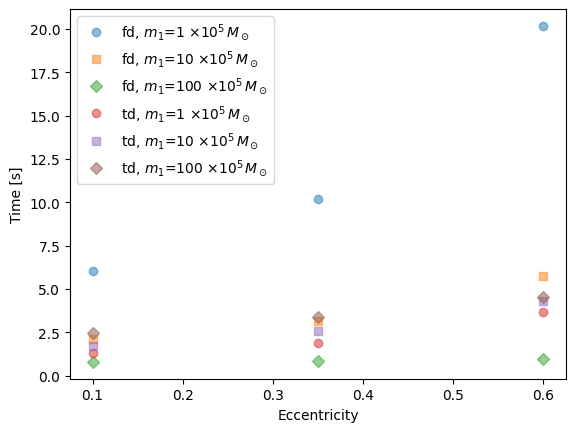
Mass invariance
If we fix the mass ratio of an EMRI system the frequency domain waveform is invariant under a total mass change as long as we consider dimensionless frequencies. We show this here as a check of our frequency domain implementation.
[28]:
from few.utils.mappings.common import muM_to_m1m2
list_h = []
list_f = []
T = 4.0
dt = 10.0
# array of total masses
Mvec = 10 ** np.linspace(5.0, 6.5, num=3)
for M in Mvec:
# fix mass ratio
mu = 5e-5 * M
m1, m2 = muM_to_m1m2(mu, M)
# rescale time
Tnew = T * (M / 1e6)
# generate wave
list_h.append(
few_gen(
m1,
m2,
a,
p0,
e0,
x0,
dist,
qS,
phiS,
qK,
phiK,
Phi_phi0,
Phi_theta0,
Phi_r0,
T=10.0,
dt=dt,
mode_selection=[(2, 2, 0)],
mask_positive=True,
)
)
# dimensionless frequency
list_f.append(few_gen.waveform_generator.create_waveform.frequency * M * MTSUN_SI)
[34]:
plt.figure()
for ii in range(len(Mvec)):
Tnew = 10.0 * Mvec[ii] / 1e6
tmp_mu = 1e-5 * Mvec[ii]
ff = list_f[ii]
ff = ff[ff >= 0.0]
h2 = np.abs(list_h[ii][0] / (tmp_mu * Tnew)) ** 2
plt.loglog(ff, h2, "--", label=f"mu = {tmp_mu:.2}, T = {Tnew:.2}", alpha=0.5)
plt.xlim([1e-4, 1e-1])
plt.legend()
plt.show()
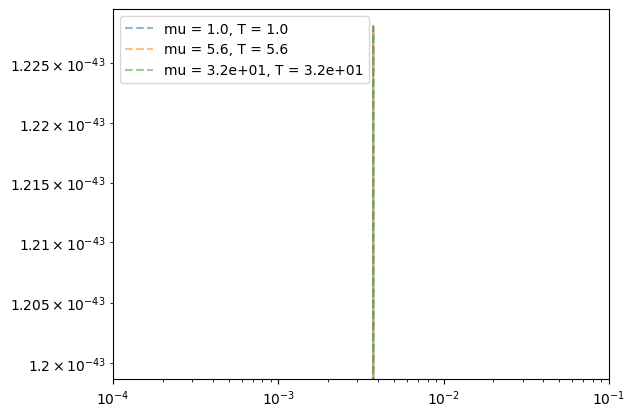
Downsampled FD Waveforms
One of the main advantages of the frequency domain formulation is that we can downsample the frequencies to reduce the computational cost of the waveform. This is illustrated in the following cells where we perform different levels of downsampling.
[23]:
m1, m2, p0, e0 = (
3670041.7362535275,
292.0583167470244,
13.709101864726545,
0.5794130830706371,
) # 1e6, 10.0, 13.709101864726545, 0.5794130830706371 #
x0 = 1.0 # will be ignored in Schwarzschild waveform
qK = np.pi / 3 # polar spin angle
phiK = np.pi / 3 # azimuthal viewing angle
qS = np.pi / 3 # polar sky angle
phiS = np.pi / 3 # azimuthal viewing angle
dist = 1.0 # distance
# initial phases
Phi_phi0 = np.pi / 3
Phi_theta0 = 0.0
Phi_r0 = np.pi / 3
Tobs = 4.0 # observation time, if the inspiral is shorter, the it will be zero padded
dt = 10.0 # time interval
eps = 1e-2 # mode content percentage
mode_selection = [(2, 2, 0)]
waveform_kwargs = {
"T": Tobs,
"dt": dt,
# you can uncomment the following ling if you want to show a mode
# "mode_selection" : mode_selection,
# "include_minus_m": True
"mode_selection_threshold": eps,
}
# get the initial p0
p0 = get_p_at_t(
traj_module,
Tobs * 0.99,
[m1, m2, 0.0, e0, 1.0],
index_of_p=3,
index_of_a=2,
index_of_e=4,
index_of_x=5,
traj_kwargs={},
xtol=2e-12,
rtol=8.881784197001252e-16,
bounds=None,
)
emri_injection_params = [
m1,
m2,
a,
p0,
e0,
x0,
dist,
qS,
phiS,
qK,
phiK,
Phi_phi0,
Phi_theta0,
Phi_r0,
]
[24]:
# FD plot
plt.figure()
alpha = [1.0, 0.9, 0.8, 0.2]
linest = ["-", "--", "-.", ":"]
for upp, aa, ls in zip([1, 100, 10000], alpha, linest):
# you can specify the frequencies or obtain them directly from the waveform
fd_kwargs = waveform_kwargs.copy()
fd_kwargs["mask_positive"] = True
# get FD waveform
hf = few_gen(*emri_injection_params, **fd_kwargs)
freq_fd = few_gen.waveform_generator.create_waveform.frequency
positive_frequency_mask = freq_fd >= 0.0
mask_non_zero = hf[0] != complex(0.0)
end_f = few_gen.waveform_generator.create_waveform.frequency[
positive_frequency_mask
][mask_non_zero].max()
if upp != 1:
num = int(len(freq_fd[positive_frequency_mask][mask_non_zero]) / upp)
p_freq = np.linspace(0.0, end_f * 1.01, num=num)
print("max frequency", end_f)
newfreq = np.hstack((-p_freq[::-1][:-1], p_freq))
# you can specify the frequencies or obtain them directly from the waveform
fd_kwargs = waveform_kwargs.copy()
fd_kwargs["f_arr"] = newfreq
fd_kwargs["mask_positive"] = True
# get FD waveform
hf = few_gen(*emri_injection_params, **fd_kwargs)
# to get the frequencies:
freq_fd = few_gen.waveform_generator.create_waveform.frequency
positive_frequency_mask = freq_fd >= 0.0
Nf = len(freq_fd[positive_frequency_mask])
plt.loglog(
freq_fd[positive_frequency_mask],
freq_fd[positive_frequency_mask] ** 2 * np.abs(hf[0]) ** 2,
ls,
label=f"$N_f = $ {Nf}",
alpha=aa,
)
ff = 10 ** np.linspace(-5, -1, num=100)
plt.loglog(ff, ff * get_sensitivity(ff), "k:", label="LISA sensitivity")
plt.ylabel(r"$|f\, \tilde{h}_{+}(f)|^2$", fontsize=16)
plt.xlabel(r"$f$ [Hz]", fontsize=16)
plt.legend(loc="lower left")
plt.xlim(1e-4, 3e-3)
plt.grid()
plt.ylim([1e-49, 1e-34])
plt.tight_layout()
plt.show()
# plt.savefig('figures/spectrum_downsampled.pdf')
max frequency 0.002815484841832867
max frequency 0.002815484841832867
